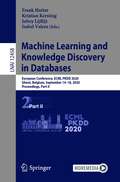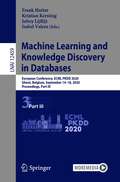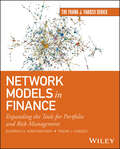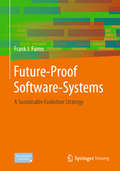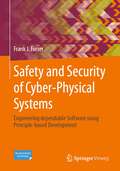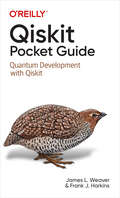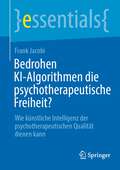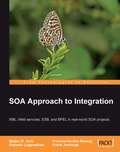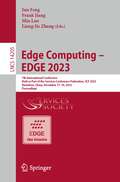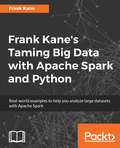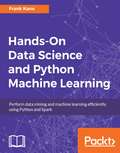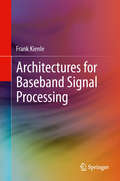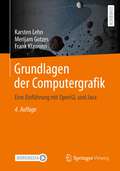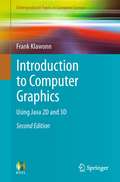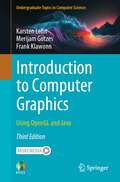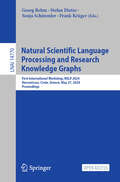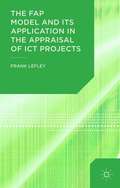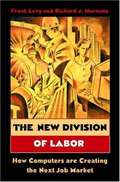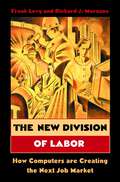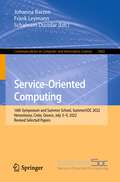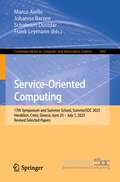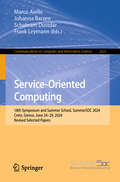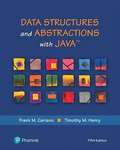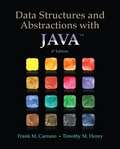- Table View
- List View
Machine Learning and Knowledge Discovery in Databases: European Conference, ECML PKDD 2020, Ghent, Belgium, September 14–18, 2020, Proceedings, Part II (Lecture Notes in Computer Science #12458)
by Kristian Kersting Frank Hutter Jefrey Lijffijt Isabel ValeraThe 5-volume proceedings, LNAI 12457 until 12461 constitutes the refereed proceedings of the European Conference on Machine Learning and Knowledge Discovery in Databases, ECML PKDD 2020, which was held during September 14-18, 2020. The conference was planned to take place in Ghent, Belgium, but had to change to an online format due to the COVID-19 pandemic.The 232 full papers and 10 demo papers presented in this volume were carefully reviewed and selected for inclusion in the proceedings. The volumes are organized in topical sections as follows: Part I: Pattern Mining; clustering; privacy and fairness; (social) network analysis and computational social science; dimensionality reduction and autoencoders; domain adaptation; sketching, sampling, and binary projections; graphical models and causality; (spatio-) temporal data and recurrent neural networks; collaborative filtering and matrix completion. Part II: deep learning optimization and theory; active learning; adversarial learning; federated learning; Kernel methods and online learning; partial label learning; reinforcement learning; transfer and multi-task learning; Bayesian optimization and few-shot learning. Part III: Combinatorial optimization; large-scale optimization and differential privacy; boosting and ensemble methods; Bayesian methods; architecture of neural networks; graph neural networks; Gaussian processes; computer vision and image processing; natural language processing; bioinformatics. Part IV: applied data science: recommendation; applied data science: anomaly detection; applied data science: Web mining; applied data science: transportation; applied data science: activity recognition; applied data science: hardware and manufacturing; applied data science: spatiotemporal data. Part V: applied data science: social good; applied data science: healthcare; applied data science: e-commerce and finance; applied data science: computational social science; applied data science: sports; demo track.
Machine Learning and Knowledge Discovery in Databases: European Conference, ECML PKDD 2020, Ghent, Belgium, September 14–18, 2020, Proceedings, Part III (Lecture Notes in Computer Science #12459)
by Kristian Kersting Frank Hutter Jefrey Lijffijt Isabel ValeraThe 5-volume proceedings, LNAI 12457 until 12461 constitutes the refereed proceedings of the European Conference on Machine Learning and Knowledge Discovery in Databases, ECML PKDD 2020, which was held during September 14-18, 2020. The conference was planned to take place in Ghent, Belgium, but had to change to an online format due to the COVID-19 pandemic.The 232 full papers and 10 demo papers presented in this volume were carefully reviewed and selected for inclusion in the proceedings. The volumes are organized in topical sections as follows: Part I: Pattern Mining; clustering; privacy and fairness; (social) network analysis and computational social science; dimensionality reduction and autoencoders; domain adaptation; sketching, sampling, and binary projections; graphical models and causality; (spatio-) temporal data and recurrent neural networks; collaborative filtering and matrix completion. Part II: deep learning optimization and theory; active learning; adversarial learning; federated learning; Kernel methods and online learning; partial label learning; reinforcement learning; transfer and multi-task learning; Bayesian optimization and few-shot learning. Part III: Combinatorial optimization; large-scale optimization and differential privacy; boosting and ensemble methods; Bayesian methods; architecture of neural networks; graph neural networks; Gaussian processes; computer vision and image processing; natural language processing; bioinformatics. Part IV: applied data science: recommendation; applied data science: anomaly detection; applied data science: Web mining; applied data science: transportation; applied data science: activity recognition; applied data science: hardware and manufacturing; applied data science: spatiotemporal data. Part V: applied data science: social good; applied data science: healthcare; applied data science: e-commerce and finance; applied data science: computational social science; applied data science: sports; demo track.
Network Models in Finance: Expanding the Tools for Portfolio and Risk Management (Frank J. Fabozzi Series)
by Frank J. Fabozzi Gueorgui S. KonstantinovExpansive overview of theory and practical implementation of networks in investment management Guided by graph theory, Network Models in Finance: Expanding the Tools for Portfolio and Risk Management provides a comprehensive overview of networks in investment management, delivering strong knowledge of various types of networks, important characteristics, estimation, and their implementation in portfolio and risk management. With insights into the complexities of financial markets with respect to how individual entities interact within the financial system, this book enables readers to construct diversified portfolios by understanding the link between price/return movements of different asset classes and factors, perform better risk management through understanding systematic, systemic risk and counterparty risk, and monitor changes in the financial system that indicate a potential financial crisis. With a practitioner-oriented approach, this book includes coverage of: Practical examples of broad financial data to show the vast possibilities to visualize, describe, and investigate markets in a completely new way Interactions, Causal relationships and optimization within a network-based framework and direct applications of networks compared to traditional methods in finance Various types of algorithms enhanced by programming language codes that readers can implement and use for their own data Network Models in Finance: Expanding the Tools for Portfolio and Risk Management is an essential read for asset managers and investors seeking to make use of networks in research, trading, and portfolio management.
Future-Proof Software-Systems: A Sustainable Evolution Strategy
by Frank J. FurrerThis book focuses on software architecture and the value of architecture in the development of long-lived, mission-critical, trustworthy software-systems. The author introduces and demonstrates the powerful strategy of “Managed Evolution,” along with the engineering best practice known as “Principle-based Architecting.” The book examines in detail architecture principles for e.g., Business Value, Changeability, Resilience, and Dependability. The author argues that the software development community has a strong responsibility to produce and operate useful, dependable, and trustworthy software. Software should at the same time provide business value and guarantee many quality-of-service properties, including security, safety, performance, and integrity. As Dr. Furrer states, “Producing dependable software is a balancing act between investing in the implementation of business functionality and investing in the quality-of-service properties of the software-systems.” The book presents extensive coverage of such concepts as: Principle-Based Architecting Managed Evolution StrategyThe Future Principles for Business Value Legacy Software Modernization/Migration Architecture Principles for Changeability Architecture Principles for Resilience Architecture Principles for Dependability The text is supplemented with numerous figures, tables, examples and illustrative quotations. Future-Proof Software-Systems provides a set of good engineering practices, devised for integration into most software development processes dedicated to the creation of software-systems that incorporate Managed Evolution.
Safety and Security of Cyber-Physical Systems: Engineering dependable Software using Principle-based Development
by Frank J. FurrerCyber-physical systems (CPSs) consist of software-controlled computing devices communicating with each other and interacting with the physical world through sensors and actuators.Because most of the functionality of a CPS is implemented in software, the software is of crucial importance for the safety and security of the CPS. This book presents principle-based engineering for the development and operation of dependable software.The knowledge in this book addresses organizations that want to strengthen their methodologies to build safe and secure software for mission-critical cyber-physical systems.The book:• Presents a successful strategy for the management of vulnerabilities, threats, and failures in mission-critical cyber-physical systems;• Offers deep practical insight into principle-based software development (62 principles are introduced and cataloged into five categories: Business & organization, general principles, safety, security, and risk management principles);• Provides direct guidance on architecting and operating dependable cyber-physical systems for software managers and architects.
Qiskit Pocket Guide: Quantum Development with Qiskit
by James L. Weaver Frank J. HarkinsThe quantum computing market is predicted to grow by nearly $1.3 billion over the next five years. Why? Given their quantum mechanical nature, quantum computers are expected to solve difficult problems in chemistry, optimization, finance, and machine learning that classical computers find impossible to unravel.This pocket guide provides software developers with a quick reference to Qiskit, an open source SDK for working with quantum computers. Packed with helpful programming examples, tables, figures, and lists, this handy book helps you find the information you need to develop and debug quantum programs.Whether you're focused on business, engineering, or scientific applications, you'll learn how to choose and apply appropriate Qiskit classes, methods, and functions.Learn how to create quantum circuits, define quantum gates, and leverage the transpilerExplore modules for implementing quantum information concepts and quantum algorithmsSurvey features of Qiskit that abstract and facilitate working with various quantum computers and simulatorsLearn how to use the latest version of the Open Quantum Assembly Language
Bedrohen KI-Algorithmen die psychotherapeutische Freiheit?: Wie künstliche Intelligenz der psychotherapeutischen Qualität dienen kann (essentials)
by Frank JacobiDie therapeutische Freiheit bezieht sich auf das Recht und die Verantwortung von Therapeut:innen, die beste Behandlungsmethode für Patient:innen auszuwählen. Es ist möglich, dass der Einsatz von KI-Algorithmen in der Psychotherapie diese Freiheit bedroht, wenn er z.B. die therapeutischen Entscheidungen dominiert oder ersetzt. Jedoch kann der Einsatz von KI-Algorithmen auch positive Auswirkungen haben, etwa im Bereich der Qualitätssicherung. Möglicherweise können Algorithmen-basierte Tools uns darin unterstützen, typische menschliche Verzerrungen und Unzulänglichkeiten bei komplexen Vorhersagen zu reduzieren. Sollten sich dann also Psychotherapeut:innen nicht die Freiheit nehmen, technische Hilfsmittel (incl. zukünftiger KI-Algorithmen) zur Unterstützung heranzuziehen…?Die wichtigste Freiheits-Bedrohung scheint darin zu liegen, dass Psychotherapeut:innen sich selbst beschränken könnten oder sich durch KI das Denken abnehmen lassen. Dieses essential gibt einen Einblick und stellt weiterführende Fragen.
SOA Approach to Integration
by Matjaz B. Juric Frank JenningsAfter explaining the challenges, levels, and strategies of integration the book explains SOA, web services, and the Enterprise Services Bus before covering processing XML and web services on the .Net and JEE platforms in more detail. Then it covers BEPL and demonstrates service composition into business processes with a realistic, although simple example BPEL process. Finally it shows how ESB provides a concrete infrastructure for SOA. This book is for architects and senior developers who are responsible for setting up SOA for integration for applications within the enterprise (intra-enterprise integration) and applications across enterprises (inter-enterprise integration or B2B).
Edge Computing – EDGE 2023: 7th International Conference, Held as Part of the Services Conference Federation, SCF 2023 Shenzhen, China, December 17-18, 2023, Proceedings (Lecture Notes in Computer Science #14205)
by Jun Feng Liang-Jie Zhang Min Luo Frank JiangThis book constitutes the refereed proceedings of the 7th International Conference on Edge Computing, EDGE 2023, held in Shenzhen, China, during December 17–18, 2023. The 8 full papers in this book were carefully reviewed and selected from 14 submissions. They were organized in topical sections as follows: Practice of Edge Computing, identify emerging research topics, and define the future of Edge Computing.
Frank Kane's Taming Big Data with Apache Spark and Python
by Frank KaneFrank Kane's hands-on Spark training course, based on his bestselling Taming Big Data with Apache Spark and Python video, now available in a book. Understand and analyze large data sets using Spark on a single system or on a cluster. About This Book • Understand how Spark can be distributed across computing clusters • Develop and run Spark jobs efficiently using Python • A hands-on tutorial by Frank Kane with over 15 real-world examples teaching you Big Data processing with Spark Who This Book Is For If you are a data scientist or data analyst who wants to learn Big Data processing using Apache Spark and Python, this book is for you. If you have some programming experience in Python, and want to learn how to process large amounts of data using Apache Spark, Frank Kane's Taming Big Data with Apache Spark and Python will also help you. What You Will Learn • Find out how you can identify Big Data problems as Spark problems • Install and run Apache Spark on your computer or on a cluster • Analyze large data sets across many CPUs using Spark's Resilient Distributed Datasets • Implement machine learning on Spark using the MLlib library • Process continuous streams of data in real time using the Spark streaming module • Perform complex network analysis using Spark's GraphX library • Use Amazon's Elastic MapReduce service to run your Spark jobs on a cluster In Detail Frank Kane's Taming Big Data with Apache Spark and Python is your companion to learning Apache Spark in a hands-on manner. Frank will start you off by teaching you how to set up Spark on a single system or on a cluster, and you'll soon move on to analyzing large data sets using Spark RDD, and developing and running effective Spark jobs quickly using Python. Apache Spark has emerged as the next big thing in the Big Data domain – quickly rising from an ascending technology to an established superstar in just a matter of years. Spark allows you to quickly extract actionable insights from large amounts of data, on a real-time basis, making it an essential tool in many modern businesses. Frank has packed this book with over 15 interactive, fun-filled examples relevant to the real world, and he will empower you to understand the Spark ecosystem and implement production-grade real-time Spark projects with ease. Style and approach Frank Kane's Taming Big Data with Apache Spark and Python is a hands-on tutorial with over 15 real-world examples carefully explained by Frank in a step-by-step manner. The examples vary in complexity, and you can move through them at your own pace.
Hands-On Data Science and Python Machine Learning
by Frank KaneThis book covers the fundamentals of machine learning with Python in a concise and dynamic manner. It covers data mining and large-scale machine learning using Apache Spark. About This Book • Take your first steps in the world of data science by understanding the tools and techniques of data analysis • Train efficient Machine Learning models in Python using the supervised and unsupervised learning methods • Learn how to use Apache Spark for processing Big Data efficiently Who This Book Is For If you are a budding data scientist or a data analyst who wants to analyze and gain actionable insights from data using Python, this book is for you. Programmers with some experience in Python who want to enter the lucrative world of Data Science will also find this book to be very useful, but you don't need to be an expert Python coder or mathematician to get the most from this book. What You Will Learn • Learn how to clean your data and ready it for analysis • Implement the popular clustering and regression methods in Python • Train efficient machine learning models using decision trees and random forests • Visualize the results of your analysis using Python's Matplotlib library • Use Apache Spark's MLlib package to perform machine learning on large datasets In Detail Join Frank Kane, who worked on Amazon and IMDb's machine learning algorithms, as he guides you on your first steps into the world of data science. Hands-On Data Science and Python Machine Learning gives you the tools that you need to understand and explore the core topics in the field, and the confidence and practice to build and analyze your own machine learning models. With the help of interesting and easy-to-follow practical examples, Frank Kane explains potentially complex topics such as Bayesian methods and K-means clustering in a way that anybody can understand them. Based on Frank's successful data science course, Hands-On Data Science and Python Machine Learning empowers you to conduct data analysis and perform efficient machine learning using Python. Let Frank help you unearth the value in your data using the various data mining and data analysis techniques available in Python, and to develop efficient predictive models to predict future results. You will also learn how to perform large-scale machine learning on Big Data using Apache Spark. The book covers preparing your data for analysis, training machine learning models, and visualizing the final data analysis. Style and approach This comprehensive book is a perfect blend of theory and hands-on code examples in Python which can be used for your reference at any time.
Architectures for Baseband Signal Processing
by Frank KienleThis book addresses challenges faced by both the algorithm designer and the chip designer, who need to deal with the ongoing increase of algorithmic complexity and required data throughput for today's mobile applications. The focus is on implementation aspects and implementation constraints of individual components that are needed in transceivers for current standards, such as UMTS, LTE, WiMAX and DVB-S2. The application domain is the so called outer receiver, which comprises the channel coding, interleaving stages, modulator, and multiple antenna transmission. Throughout the book, the focus is on advanced algorithms that are actually in use in modern communications systems. Their basic principles are always derived with a focus on the resulting communications and implementation performance. As a result, this book serves as a valuable reference for two, typically disparate audiences in communication systems and hardware design.
Grundlagen der Computergrafik: Eine Einführung mit OpenGL und Java
by Frank Klawonn Karsten Lehn Merijam GotzesComputergrafik umfasst die Erzeugung und Darstellung von einfachen Grafikelementen und Bildern bis hin zur Virtual Reality. Die Anwendung dieser Techniken profitiert von einem soliden Verständnis der entsprechenden Grundlagen. Das erfolgreiche Buch von Prof. Klawonn, das jetzt bereits in der dritten Auflage vorliegt, vermittelt genau das - verständlich und nachvollziehbar. Prof. Klawonn erläutert die wesentlichen Konzepte an konkreten Beispielen und bedient sich dabei der einfachen Sprachmittel der Javaprogrammierung. Die Umsetzung erfolgt praktisch mit Java 2D und Java 3D. Auch zur dritten Auflage gibt es wieder einen umfangreichen Online-Service mit Beispielprogrammen, Aufgaben und Lösungen, Folien und farbigen Illustrationen.
Introduction to Computer Graphics
by Frank KlawonnThis book is an essential tool for second-year undergraduate students and above, providing clear and concise explanations of the basic concepts of computer graphics, and enabling the reader to immediately implement these concepts in Java 2D and/or 3D with only elementary knowledge of the programming language. Features: provides an ideal, self-contained introduction to computer graphics, with theory and practice presented in integrated combination; presents a practical guide to basic computer graphics programming using Java 2D and 3D; includes new and expanded content on the integration of text in 3D, particle systems, billboard behaviours, dynamic surfaces, the concept of level of detail, and the use of functions of two variables for surface modelling; contains many pedagogical tools, including numerous easy-to-understand example programs and end-of-chapter exercises; supplies useful supplementary material, including additional exercises, solutions, and program examples, at an associated website.
Introduction to Computer Graphics: Using OpenGL and Java (Undergraduate Topics in Computer Science)
by Frank Klawonn Karsten Lehn Merijam GotzesA basic understanding of the key techniques in computer graphics can open the door to this exciting field and its many applications, including for video games and for augmented and virtual reality.This easy-to-follow textbook and reference introduces the fundamental concepts of computer graphics, integrating both technical background and theory with practical examples and applications throughout. Thoroughly revised and updated, this new edition continues to present a user-friendly approach to creating images and animations, complementing the expanded coverage of topics with usage of example programs and exercises.Topics and features:Contains pedagogical tools, including easy-to-understand example programs and end-of-chapter exercisesPresents a practical guide to basic computer graphics programming using the Open Graphics Library (OpenGL) and the widely used Java programming languageIncludes new and expanded content on the OpenGL graphics pipelines, shader programming, drawing basic objects using the OpenGL, three-dimensional modelling, quaternions, rasterisation, antialiasing and moreSupplies complete Java project examples as supplementary materialThis reader-friendly textbook is an essential tool for second-year undergraduate students and above, providing clear and concise explanations of the basic concepts of computer graphics. It will enable readers to immediately implement these concepts using the OpenGL and Java (with only elementary knowledge of the programming language).Prof. Dr.-Ing. Karsten Lehn works at the Faculty of Information Technology at Fachhochschule Dortmund, University of Applied Sciences and Arts. Prof. Dr. Merijam Gotzes is teaching at Hamm-Lippstadt University of Applied Sciences. Prof. Dr. Frank Klawonn is head of the Data Analysis and Pattern Recognition Laboratory at the Ostfalia University of Applied Sciences and heads the Biostatistics Research Group at the Helmholtz Centre for Infection Research.
Natural Scientific Language Processing and Research Knowledge Graphs: First International Workshop, NSLP 2024, Hersonissos, Crete, Greece, May 27, 2024, Proceedings (Lecture Notes in Computer Science #14770)
by Stefan Dietze Georg Rehm Frank Krüger Sonja SchimmlerThis Open Access book constitutes the refereed proceedings of the First International Workshop on Natural Scientific Language Processing and Research Knowledge Graphs, NSLP 2024, held in Hersonissos, Crete, Greece, on May 27, 2024. The 10 full papers and 11 short papers included in this volume were carefully reviewed and selected from a total of 26 submissions. The proceedings aims to bring together researchers working on the processing, analysis, transformation and making use-of scientific language and research knowledge graphs including all relevant sub-topics.
Organisation und Führung in turbulenten Zeiten: Entwurf und Implementierung unter Verwendung des 3-P-Modells
by Peter Wollmann Frank Kühn Michael Kempf Reto PüringerDieses Buch knüpft an die erfolgreiche Entwicklung des Drei-Säulen-Modells (3-P-Modell) der Autoren für die Organisation und Führung in disruptiven Zeiten an. Der Schwerpunkt liegt darauf, dem Leser bei der Umsetzung des Modells zu helfen und eine Vielzahl von Anwendungsfällen für diese VUCA-Zeiten (Volatilität, Ungewissheit, Komplexität und Mehrdeutigkeit), einschließlich globaler Krisen wie der COVID-19-Pandemie, zu liefern. Das Buch deckt ein breites Spektrum von Organisationen ab: privater und öffentlicher Sektor, Nichtregierungsorganisationen, lokale und globale Regierungsinstitutionen, globale Organisationen wie die UNO usw. Darüber hinaus wird aufgezeigt, wie das 3-P-Modell auf Herausforderungen bei der Organisationsgestaltung, dem Management und der Führung angewendet werden kann.
The FAP Model and Its Application in the Appraisal of ICT Projects
by Frank LefleyVarious formal techniques are used for the analysis of capital projects, but are often limited by their scope and by the difficulty of interpreting the significance of the results they produce. Many perceived benefit factors are left out of existing appraisal processes because they lack precise financial quantification. Significantly revised and rewritten, based on the 2005 publication The Financial Appraisal Profile Model; this book discusses how the FAP model can present an integrated process for the appraisal of financial and strategic benefits and the assessment of risk in ICT (Information Communication Technology) project proposals. It presents a pragmatic solution to resolve many of the problems faced by organisations considering investment, not only in ICT but in all medium to large scale projects. The book demonstrates how the FAP model progresses the literature and practice of corporate finance by profiling the financial, risk and strategic elements of an investment decision. Including a review of other existing financial risk and strategic appraisal models, this book explores the perception that ICT projects have different requirements to others, and highlights important issues regarding ICT globalisation, project champions, post audits and appraisal teams. This comprehensive case-study, based on research in applying the FAP model to an ICT capital project, addresses issues such as 'groupthink' and the influence of a 'project champion' on the evaluation of capital projects.
The New Division of Labor: How Computers Are Creating the Next Job Market
by Frank Levy Richard J. MurnaneAs the current recession ends, many workers will not be returning to the jobs they once held--those jobs are gone. In The New Division of Labor, Frank Levy and Richard Murnane show how computers are changing the employment landscape and how the right kinds of education can ease the transition to the new job market. The book tells stories of people at work--a high-end financial advisor, a customer service representative, a pair of successful chefs, a cardiologist, an automotive mechanic, the author Victor Hugo, floor traders in a London financial exchange. The authors merge these stories with insights from cognitive science, computer science, and economics to show how computers are enhancing productivity in many jobs even as they eliminate other jobs--both directly and by sending work offshore. At greatest risk are jobs that can be expressed in programmable rules--blue collar, clerical, and similar work that requires moderate skills and used to pay middle-class wages. The loss of these jobs leaves a growing division between those who can and cannot earn a good living in the computerized economy. Left unchecked, the division threatens the nation's democratic institutions. The nation's challenge is to recognize this division and to prepare the population for the high-wage/high-skilled jobs that are rapidly growing in number--jobs involving extensive problem solving and interpersonal communication. Using detailed examples--a second grade classroom, an IBM managerial training program, Cisco Networking Academies--the authors describe how these skills can be taught and how our adjustment to the computerized workplace can begin in earnest.
The New Division of Labor: How Computers Are Creating the Next Job Market
by Frank Levy Richard J. MurnaneAs the current recession ends, many workers will not be returning to the jobs they once held--those jobs are gone. In The New Division of Labor, Frank Levy and Richard Murnane show how computers are changing the employment landscape and how the right kinds of education can ease the transition to the new job market. The book tells stories of people at work--a high-end financial advisor, a customer service representative, a pair of successful chefs, a cardiologist, an automotive mechanic, the author Victor Hugo, floor traders in a London financial exchange. The authors merge these stories with insights from cognitive science, computer science, and economics to show how computers are enhancing productivity in many jobs even as they eliminate other jobs--both directly and by sending work offshore. At greatest risk are jobs that can be expressed in programmable rules--blue collar, clerical, and similar work that requires moderate skills and used to pay middle-class wages. The loss of these jobs leaves a growing division between those who can and cannot earn a good living in the computerized economy. Left unchecked, the division threatens the nation's democratic institutions. The nation's challenge is to recognize this division and to prepare the population for the high-wage/high-skilled jobs that are rapidly growing in number--jobs involving extensive problem solving and interpersonal communication. Using detailed examples--a second grade classroom, an IBM managerial training program, Cisco Networking Academies--the authors describe how these skills can be taught and how our adjustment to the computerized workplace can begin in earnest.
Service-Oriented Computing: 16th Symposium and Summer School, SummerSOC 2022, Hersonissos, Crete, Greece, July 3–9, 2022, Revised Selected Papers (Communications in Computer and Information Science #1603)
by Frank Leymann Schahram Dustdar Johanna BarzenThis book constitutes the revised selected papers of the 16th Symposium and Summer School on Service-Oriented Computing, SummerSOC 2022, held in Hersonissos, Crete, Greece, in July 2022.The 8 full papers and 1 short paper presented in this volume were carefully reviewed and selected from 25 submissions. They were organized in topical sections as follows: Advanced Application Architecture; Data Science and Applications; and Quantum Computing.
Service-Oriented Computing: 17th Symposium and Summer School, SummerSOC 2023, Heraklion, Crete, Greece, June 25 – July 1, 2023, Revised Selected Papers (Communications in Computer and Information Science #1847)
by Frank Leymann Schahram Dustdar Marco Aiello Johanna BarzenThis book constitutes the refereed proceedings of the 17th Symposium and Summer School, SummerSOC 2023, held in Heraklion, Crete, Greece, in June 25–July 1, 2023.The 6 full papers and 3 short papers presented in this book were carefully reviewed and selected from 27 submissions.They are organized in the following sections as follows: Distributed Systems; Smart; and Mixed Technologies.
Service-Oriented Computing: 18th Symposium and Summer School, SummerSOC 2024, Crete, Greece, June 24–29, 2024, Revised Selected Papers (Communications in Computer and Information Science #2221)
by Frank Leymann Schahram Dustdar Marco Aiello Johanna BarzenThis book constitutes the refereed proceedings of the 18th Symposium and Summer School on Service-Oriented Computing, SummerSOC 2024, held in Crete, Greece, during June 24–29, 2024. The 8 revised full papers and 1 short paper presented in these proceedings were carefully reviewed and selected from 24 submissions. They cover the following topics: modeling the digital world; quantum computing; data platforms.
Data Structures And Abstractions With Java
by Frank M. Carrano Timothy M. HenryUsing the latest features of Java 5, this unique object-oriented presentation introduces readers to data structures via thirty, manageable chapters. KEY FeaturesTOPICS: Introduces each ADT in its own chapter, including examples or applications. Provides aA variety of exercises and projects, plus additional self-assessment questions throughout. the text Includes generic data types as well as enumerations, for-each loops, the interface Iterable, the class Scanner, assert statements, and autoboxing and unboxing. Identifies important Java code as a Listing. Provides Notes and Programming Tips in each chapter. For programmers and software engineers interested in learning more about data structures and abstractions.
Data Structures and Abstractions with Java (Fourth Edition)
by Frank M. Carrano Timothy M. HenryA book for an introductory course in data structures, typically known as CS-2.
